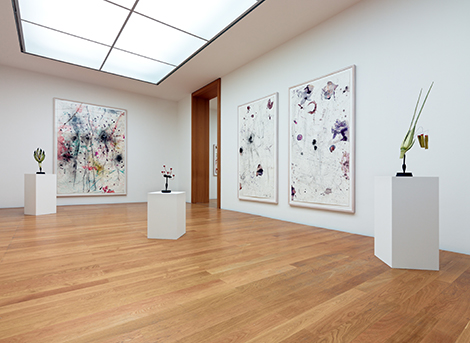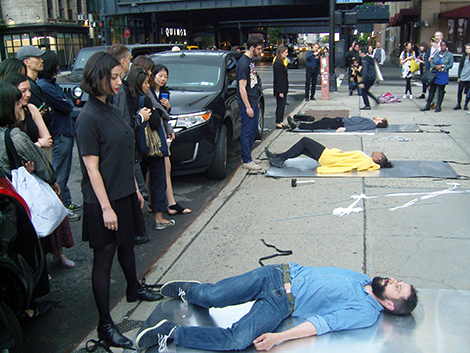A short interview with... Martin Herbert!
Summeracademy: What are in your opinion the most important skills when writing about art?
Martin Herbert: The ability to render complex ideas in clear and comprehensible language, not hiding behind jargon Relatedly: readability. The ability to describe evocatively – to give a sense of what it was like to be in front of the work, and to think it through. Again relatedly: the capacity to see what is in front of you, not just what the press release says, and to put it into some kind of context.
[Course of Jennifer Allen, 2014 Summer Academy, photo: Pia Streicher]
S: What represents a good, let’s say, art review for you?
M: Aside from the above, I think there should be a balance of description and analysis. Writers, particularly nowadays, often tend to think that just describing is enough. This leads to very cautious criticism. Ideally the writing should also have some style; style, how you say something, can be as communicative as direct argument.
[Martin Herbert: Tell Them I Said No, Sternberg Press, New York 2016]
S: What are you going to teach your students?
M: How different aspects of art writing work, and how they differ: the review, the feature, the catalogue essay, the interview, the press text. We’re going to move from looking at art to writing about it, to consider the structures underlying each kind of critical writing (and how writers have moved experimentally beyond them). I’d also like to propose that writing about things is a way of understanding what we think, and how we think, that enriches the experience of looking at art.
A short interview with... Aisha Khalid
Summeracademy: Why miniature painting?
Aisha Khalid: It's a water based medium and usually we use natural pigments ... there are on the one hand several things involved in this technique like paper making, brush making, colour mixing etc. and on the other hand the whole way of looking at things in miniature painting is different.
Actually it's a traditional technique and very near to my nature of working. This is not just technique but the whole way of working in which we sit on the floor and mainly do everything in that position. It is a very meditative process of painting where one can spend hours on one surface as it is very calming and peaceful. I love this process and I get everything from the process.
I am a traditionally trained miniature painter and with this background I am working as an independent artist for the last 25 years. The wish to thread the thin line between the demands of the discipline and to break away from conventionalities of the discipline has been the focus of my initial work.
[Photo: At if Saeed and Kamran Saleem]
S: What is your contemporary approach to this traditional technique?
A: I believe tradition is not a static form it's something which evolves with the time. I take this technique and and have been evolving it from small scale paintings and books and albums to a large scale works and from two dimensional to three dimensional sculptures to four dimensional site-specific installations in architectural spaces in different countries. So I don't see any limitation in this technique just because it's coming from a traditional background.
Now I am more engaged with the forms and its relationship with mechanical/geometrical patterns, division and transformation of space within a multilayered approach. I am more playing with form and space and it’s more personalised as well as political.
I wanted to share my own artistic, practice and experiences with this technique where I am doing contemporary paintings on traditional surface and medium, but the size of these paintings is no more miniature they are 4x8 feet large scale with the same minute details. I am also working with the same medium on site-specific installations, where I am dealing with architectural space. Also the city scape of Kabul became part of my work (done with same technique of miniature painting), there this two dimensional technique became interactive, and the audience saw themselves in the mirror with painted images of vortex which became a wound on their own bodies.
S: What is the special thing about the Salzburg Summer Academy for you? What do you like about it?
A: I like the idea of the Summer Academy, especially I like that students and teachers are from diverse backgrounds and from different countries, it is a quite international place so students can get exposure. I think the duration of courses and the time when it happened is a great opportunity for those who can not afford to spend more time outside there homes or studios.
I also like the idea of having this academy in an old fortress. This city has so many beautiful museums and galleries and historical references, the richness of the culture of this city fascinates me.
open cALL - Global Academy conference
OPEN CALL for Pecha Kucha transcultural exchange
Deadline: May 15, 2018
The Salzburg International Summer Academy of Fine Arts is planning the conference
Global Academy II, Examples of Transcultural Exchange
August 11–12, 2018
Concept: Hildegund Amanshauser, Kimberly Bradley
For the past several years, the Salzburg International Summer Academy of Fine Arts has hosted the Global Academy project – a series of conferences and exchanges that focus on questions of learning and teaching art in a global context.
The 2016 conference addressed alternative academies in the Global South; the meetings in 2018 will present various models of transcultural artistic exchange and ask the following questions: How does (or could) transcultural exchange occur beyond the current binary categories of colonial-postcolonial or north-south, never forgetting our colonial pasts and the current situations that frame this kind of exchange? What projects exist and how do they work? How do artists, curators, and institutions address transcultural issues? Which methods do they use to root themselves in various regions of the world and make themselves understood?
Open Call Pecha Kucha
We are looking for artists, curators, activists and other cultural workers who have developed new, innovative projects in the field of transcultural exchange – either already realized or still in the conceptual stage – with a special focus on projects rooted in the Global South. We would like you to talk about the concept, objective, people involved, audiences you want to reach, financing, and challenges.
Who can apply?
Anyone whose work deals with the subject matter of the conference (see conference description and lineup below). Artists, curators, cultural workers, writers, teachers, researchers, activists, or students who wants to present a specific project in the Pecha Kucha format are welcome to apply.
What is Pecha Kucha?
Pecha Kucha 20 x 20 is a simple presentation format where the speaker shows 20 images, each for 20 seconds. The images advance automatically and the speaker explains them as they appear.
What do you get?
Travel costs (flight, train, bus, public transport); hotel (max. three nights); plus an expense allowance of 25 euros per day.
Application documents: CV, and a short description of the project you would like to present (no more than 300 words, and please note a website, if you have one).
Please state your point of departure and mode of travel (flight, train, etc.).
Application deadline May 15, 2018 Submit your written applications to office@summeracademy.at
A jury will select the participants.
Further details: office@summeracademy.at, www.summeracademy.at
tel. +43 662 842 113
[Global Academy conference 2016, photo: Mira Turba]
Schedule for participants
Saturday, August 11, 2018
Keynote lecture: Shuddhabrata Sengupta
Panel 1
Negotiation: Which models allow new modes of transcultural artistic exchange?
Alexander Koch; gallerist/New Patrons, Europe
Charles Esche; director Van Abbemuseum Eindhoven, NL
Marina Fokidis; writer, editor, curator, South magazine, Kunsthalle Athina
Clementine Deliss; curator, researcher, publisher
Panel 2
Beyond the binary: What (could) come(s) after North/South, colonial/postcolonial, Eurocentric/“global”?
Bouchra Khalili, artist
Will Furtado, contemporary & deputy editor
Natasha Ginwala; curator, researcher, and writer
Paul Feigelfeld; artist, media theorist (to be confirmed)
18:30 Pecha Kucha, four presentations, open call
Sunday, August 12
Panel 3
(Re)writing (art) history now: who does it, how, and where?
Diana Campbell Betancourt; curator, art historian, Dhaka Art Summit, Samdani Art Foundation
Stephanie Bailey; Ibraaz senior editor, Ocula editor-at-large, art critic and theorist
Ahlam Shibli, artist
Eva Barois De Caevel; independent curator, curator at RAW Material Company + coordinator of the RAW Academy (Senegal).
Pecha Kucha, four presentations, open call
Panel 4
Where do we go from here?
Tony Chakar, artist
Marina Fokidis, writer, editor, curator, South magazine, Kunsthalle Athina
Emeka Okereke, artist (to be confirmed)
Sabine B Vogel (art critic)
Observers: Cristina Bogdan, art critic and editor, Martin Herbert, art critic and editor
Moderators: Hildegund Amanshauser, Cristina Bogdan, Kimberly Bradley, Martin Herbert
A short interview with... Hubert Scheibl
Hubert Scheibl: In erster Linie geht es mir um eine bestimme Unruhe, um eine Art Energie, die irgendwie in mir drinnen ist und die ich festhalten und in meine Malerei einbringen muss. Ich glaube nicht, dass ein Bild die Welt verändert. Aber Kunst ist immer noch ein sehr hoher Ausdruck von Hoffnung.
S: Was wollen Sie Ihren Stuiderenden beibringen?
A short interview with... Yorgos Sapountzis
Summeracademy: How important is performance in your work? What is your preferred material and why?
Yorgos Sapountzis: I worked in the theater for years. From the age of 20 to 25 I was a stage designer and assistant directtor for a theater group in Athens. Even today I’m fascinated by that moment of selfabandonment that’s always there when some one exposes themselves before an audience and starts playing a role. This moment is so important because it’s precisely this we need to learn: the ability to feel through and with others. This is why, as far as my own work is concerned, I only call those works performances where I have an audience. And because this special element of feeling through others can only take place given human presence, I hardly ever turn such performances into video works after the event. 
[Yorgos Sapountzis, Performance]
There’s one idea underlying all of my performances: “Here I am! I’m here for you now!” Time plays a role, the audience’s gaze, and their empathy with me, the performer. You can’t translate that into videos. Each time I have to overcome my fear of presenting myself to people again.
So there I stand with my materials, and with their aid I try to construct a story or an experience. Basically, everything that I do as an artist is born of this element of performance. Experiences during a performance are so strong that they often eclipse everything else in my memory. My memories of my performances point the way to my other works.
[Yorgos Sapountzis, Performance, The Kitchen, NY, 2014]
:: Next >>









